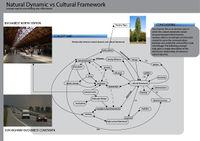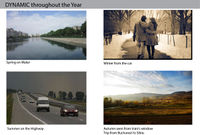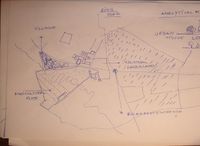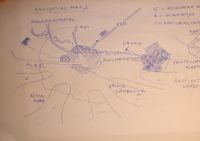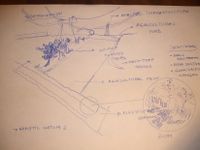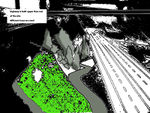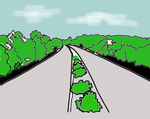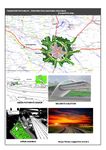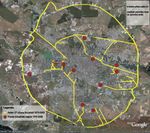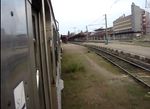Planting Design 2013 Working Group 9 - Case Study A
---> back to group page working group 9
Planting Systems Along Transport Pathways
- Motto:
A garden is a complex of aesthetic and plastic intentions; and the plant is, to a landscape artist, not only a plant - rare, unusual, ordinary or doomed to disappearance -but it is also a color, a shape, a volume or an arabesque in itself. Roberto Burle Marx
Rationale: Why is this case interesting?
'The selected site is composed by the planted areas nearby the transportation paths (railways, roads, highways and many others) that penetrate the capital city of Romania, Bucharest.We are looking at what types of plants are used in creating the landscape of the transportation paths, how a traveller perceives the plants as a train, a bus or a car is travelling with bigger or smaller speed.'
- 'Why did you select it?'
I consider that studying the dynamics of the planting design structures along the transportation infrastructuctures that penetrate a town would give a general image about how planting is perceived by the local authorities of that town, or by general public. Everything started with travelling with train and questions about what you can see through the window of the train. Is it same as you walk or is it different? Of course it was different, so the perception of the same thing, in this case study, the vegetation groups is different as the speed of travel increases. Bucharest is the capital city of Romania, concentrating the widest variety and most complex transport infrastructure of the country. In the same time it is located in a plain area, the Romanian Plain, also known as the Wallachian Plain, with a temperate continental climate, being rich in plants that are characteristic for a plain area.
Within the Romanian Plain there can be found four general types of plants: central europeans( Quercus Pedunculata, Malus Silvestris, Crataegus monogyna, Cornus mas, Sorbus torminalis, Tilia cordata, Ulmus glabra); eurasian(different species of Populus, Salix and Ulmus); pontics( graminae); mediteranean( Quercus cerris, Quercus frainetto, Quercus sessiliflora, Quercus pubescens).
- Is it exemplary for a specific theme or a problem?
It's an exemplary of mobility planting landscape along with the problems that come from various planting ways.
- 'In how far does it relate to your life?'
It affects my life everytime I travel with train or bus or other transport mean, everything that is planted left or right side of the transport path is sometimes what accompanies me and many others in our trips.
Author's perspective
- My name is Elena and I had graduated Urban Design and Planning.
- After graduation I wanted a different path in my life and therefor I went for Master in Landscape Architecture in the same university , out of passion for plants and gardening and looking for an alternative to what is today's tendency of expansion of cities. Studies in Landscape Architecture actually brought a new set of challenges. In the virtue of my main study background I had chosen a case that is linked with the cities, but I wish to see it from a different perspective compared to what is usually seen either by a urban designer or by a landscape architect, and in that case I added the speed and I am trying to give answer to this question of how nature is perceived when we discuss of speed.
- With this case study I wish to raise a question about what can be perceived with the increase of speed by travelling. Normally landscape architects focus on how a certain area looks from a static point of view, but I wish to go further with this study. I am very much sure that had been many studies before regarding this aspect for many years, therefor the road designers know how to design the roads in order to avoid accidents and many other aspects, but here wish to talk about the perception aspect of the transport landscape. Considering speed, it's obvious a traveller will not consider singular plants but rather whole groups or planted massives. What will matter will be how big, how wide, what color, what texture that vegetation has. Given the speed the rythm can be diffeerent.
Landscape and/or urban context of your case
- Biogeography, cultural features, overall character, history and dynamics
Bucharest. Cultural Features
Bucharest is the capital city of Romania, situated at a latitude of "number", and a longitude of "number". It has 2 million inhabitants. It is the largest city of Romania, laying on the banks of river Dambovita, 70 km north to Danube. It was mentioned in the documents in 1459 and became capital of Romania in 1862 and it's the center of Romanian media, culture and art. Romanian legend has it that the city of Bucharest was founded on the banks of the Dambovita River by a shepherd named Bucur, whose name literarily means "joy." His flute playing reportedly dazzled the people and his hearty wine from nearby vineyards endeared him to the local traders, who gave his name to the place.
Bucharest is a city frequently depicted as an in the middle of situate and occident". Thus it could be acknowledged, as it is an European city with an un-common structure for both space-building conventions. The Bucharest scene is ruled by arrangement, by peculiar juxtapositions of striking innovation, rural custom (lord of provincial middle class space), cement totalitarian cuts, sub-urban half ad libbed neighbourhoods and Parisian synthetic. Its tissue is an astonishing result of a, recently universal, "take off all of a sudden" urban politic. It a hard-to-see city, stowed away by the inpatient visitor eye and who require delicate and long walking around uncover its soul.
Its gigantic fixed figure its scattered by green spots. Some of them are parks "à la française", some of them are "socialist current" stops, parcel of neglected regions full of secret and, a large portion of them, cosy private arrangements sifted by pretty much rash wall. These green structure is likewise an aftereffect of blending rationales. While the old center of the city full of courts and arrangements originated from the verifiable improvement of a somewhat oriental city, the primary parks are a consequence of 19's century French display both from spatial rationale and outline perspective. The levelness of his site is crossed by two watercourses. The main is the precise focal Dambovita, which came to be, in her long history, from a wild spread and full of imperativeness waterway, an ignoble channel in cement with filthy tan water. In the North side Colentina had an alternate predetermination as her sloppy water was changed in the 30es in a lake chain which structure a green urban stream.
Today, this rich urban scene appears to be debilitated by an unseeing ardor for business building design that gradually blankets what rests for the old delightful Bucharest. Urban legislative issues appears to disregard (aside from hypotheses and talks) all thought of scene, patrimony or excellence. The rationale at work is one of (too) late innovation, reviewing all colossal western mix-ups of the 50es or 60es. Tight functionalism is still on and green space is acknowledged as space and cash wasteful urban capacity and non-beneficial in a city that tries to reveal to its "western nerve". At the same time individuals start to recover general society space, to utilize and convert it.
Romanian Railways
The Romanian Railways started in 1880, even though there were built already some railway networks since 1854. "The railway network of Romania consists of 11,380 km (7,070 mi), of which 3,971 km (2,467 mi) (34.9%) are electrified, and the total track length is 22,247 km (13,824 mi), of which 8,585 km (5,334 mi) (38.5%) are electrified."[Wikipedia] The headquarter of Romanian Railways is in the capital city Bucharest.
"Between 1864 and 1880, several railways were constructed in the area of the Kingdom of Romania. On 1 September 1865, the English company John Trevor-Barkley began construction on the Bucharest–Giurgiu line. Commissioned by the King of Romania, the line was opened to traffic on 26 August 1869. The Bucharest-Giurgiu line was the first railway built on Romanian territory at that time (considering that the Oraviţa-Baziaş line was part of Austria-Hungary, even though it presently lies on Romanian territory)."[wikipedia]
Other lines that cross Bucharest were built in 1866 with the vote of the parliment. In 1868 Bucharest's North Station was finalised.
- Illustration: Map; sketches; short descriptive analyses
Analytical drawings
Please add four analytical sketches/drawings (or montages/schemes) of your case and take the following aspects into account:
- natural dynamic versus cultural framework - in how far do these two forces come together in your case?
As seen in the analytical drawing 2 the cultural framework dominates clearly the natural dynamic, and the plants and entire nature are there to serve the culture: either as protection curtains or sometimes as agricultural plots. However the perception is not only built entirerly on the main plan but also the foreground needs to be taken into account. Considering this aspect I had made a short analize of how a 360 view would look like in analytical drawing 3 and what elements dominate the landscape there.
- dynamic through the year (you may imagine how the site looks in spring and summer, maybe you also remember it)
I've chosen to show what you can perceive from different means of transport: on water, from highway, from the train, or from a car in the town in different seasons. According to own perception the most dramatic images are obtained from train or sometimes from car, in autumn and winter.In autum the color of the leaves of the trees gives a romatic allure to the landscape, while in winter the presence of snow, reduced light, street lighting and presence of couples and of cultural celebrations like Cristmas and approaching holidays would give a very special hallow to the iamges taken.
- highlight potentials and problems
- Image Gallery
Natural Dynamic vs Cultural Framework- a concept map of which conclusion is this case study is an obvious case in which the culture dominates nature because transport infrastructure nearby cities is an antropic environment created to serve the communication between one node(city) and another node(city/ village). The following concept map gives a simple description of the dominance relationship of culture to nature.
Projective drawings
- Please add four projective sketches/drawings (or montages/schemes) for your case and take the following aspects into account:
- How would you like this case to change in the near future? (in 1-2 years)
Because Bucharest is a city that benefits both from its beautiful lakes but also from presence of river Dambovita I would like to see that local authorities would start to consider planting more local trees, that would later on form surrounding forests. It would be also nice to see bigger use of groups of vegetation, shrubs and why not a wider variety of colors. What I don't like about nowadays entrance in Bucharest is the waste management and I think this can be improved.
- And how could it look like in 10-15 years?
Considering the fact that maybe some forestation process would start in 10-15 years there would be seen some real results. Of course it's fairly difficult to anticipate how things will look like in 2028-2030. I think probably the infrastructure today would go wider and probably in that time frame it would be possible to see first speed train also in Bucharest. Green walls are a good idea to consider in the stations, as for outside town small things like forestation and/or proper waste management can improve dramatically the image nowadays.
- Projective Drawings
Summary and conclusion
Please summarize your case and give arguments for your projective design (approx 150 words). To sum up, I would like to say that simple changes can really improve the aspect of nowadays transport pathways. I believe in use of vegetation and landscape architecture to improve the quality of life standard in a town, therfor my suggestion for the projective design are green walls for the outer train stations and a forest ring for the town or at least marking the most important entries in the town with studied shapes and forms regarding vegetation. Agricultural fields can be combined in interesting forms with groups of massive trees. The results will not be seen in a moment, but I think that is the beauty of a landscape that it's constantly changing, though some of the elements might remain a constant. Of course there is no such thing as a unique solution, but some arguments for proceeding such way would be raising the atractiveness of the city and also the quality of Bucharest's air.
Image Gallery
You may add a series of images/photos in addition to the sketches/drawings
- Image Gallery
- Yourfilename3.jpg
image 3
- Yourfilename4.jpg
image 4
References
- http://www.unibuc.ro/prof/sandulache_m_i/Campia_Romana_-_curs_3.php
- http://www.romaniatourism.com/bucharest.html
- http://en.wikipedia.org/wiki/Bucharest
- http://www.urban-landscape.net/content_public/city_details.php?stadt_id=161
About categories: You can add more categories with this tag: "", add your categories


